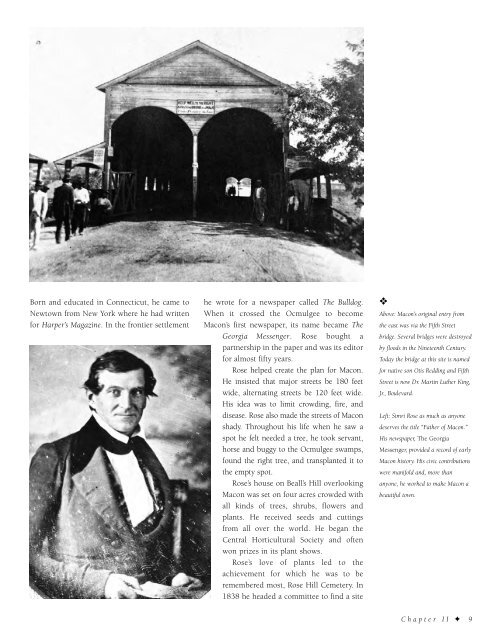Historic Macon
An illustrated history of the city of Macon, paired with the histories of companies, families and organizations that make the region great.
An illustrated history of the city of Macon, paired with the histories of companies, families and organizations that make the region great.
You also want an ePaper? Increase the reach of your titles
YUMPU automatically turns print PDFs into web optimized ePapers that Google loves.
Born and educated in Connecticut, he came to<br />
Newtown from New York where he had written<br />
for Harper’s Magazine. In the frontier settlement<br />
he wrote for a newspaper called The Bulldog.<br />
When it crossed the Ocmulgee to become<br />
<strong>Macon</strong>’s first newspaper, its name became The<br />
Georgia Messenger. Rose bought a<br />
partnership in the paper and was its editor<br />
for almost fifty years.<br />
Rose helped create the plan for <strong>Macon</strong>.<br />
He insisted that major streets be 180 feet<br />
wide, alternating streets be 120 feet wide.<br />
His idea was to limit crowding, fire, and<br />
disease. Rose also made the streets of <strong>Macon</strong><br />
shady. Throughout his life when he saw a<br />
spot he felt needed a tree, he took servant,<br />
horse and buggy to the Ocmulgee swamps,<br />
found the right tree, and transplanted it to<br />
the empty spot.<br />
Rose’s house on Beall’s Hill overlooking<br />
<strong>Macon</strong> was set on four acres crowded with<br />
all kinds of trees, shrubs, flowers and<br />
plants. He received seeds and cuttings<br />
from all over the world. He began the<br />
Central Horticultural Society and often<br />
won prizes in its plant shows.<br />
Rose’s love of plants led to the<br />
achievement for which he was to be<br />
remembered most, Rose Hill Cemetery. In<br />
1838 he headed a committee to find a site<br />
❖<br />
Above: <strong>Macon</strong>’s original entry from<br />
the east was via the Fifth Street<br />
bridge. Several bridges were destroyed<br />
by floods in the Nineteenth Century.<br />
Today the bridge at this site is named<br />
for native son Otis Redding and Fifth<br />
Street is now Dr. Martin Luther King,<br />
Jr., Boulevard.<br />
Left: Simri Rose as much as anyone<br />
deserves the title “Father of <strong>Macon</strong>.”<br />
His newspaper, The Georgia<br />
Messenger, provided a record of early<br />
<strong>Macon</strong> history. His civic contributions<br />
were manifold and, more than<br />
anyone, he worked to make <strong>Macon</strong> a<br />
beautiful town.<br />
Chapter II ✦ 9
















